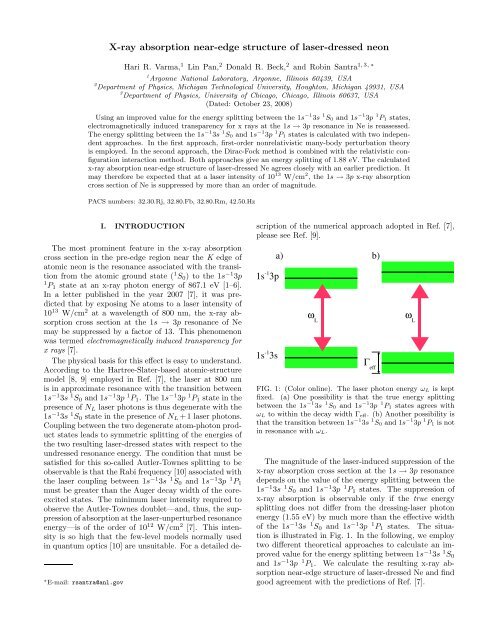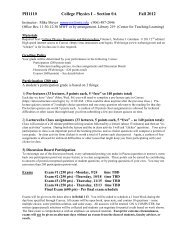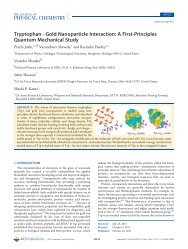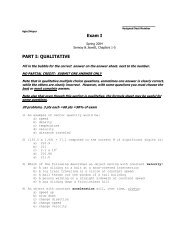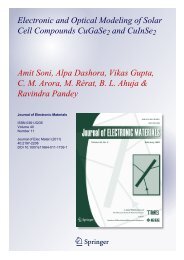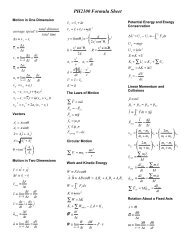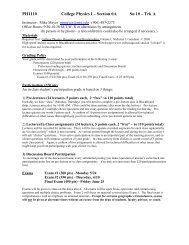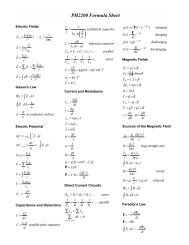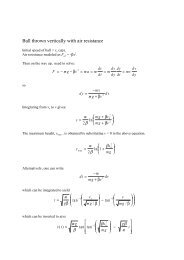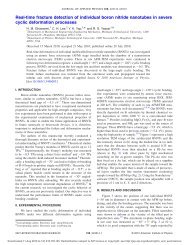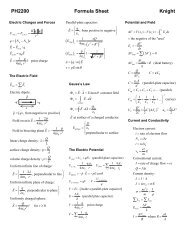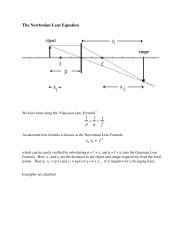X-ray absorption near-edge structure of laser-dressed neon
X-ray absorption near-edge structure of laser-dressed neon
X-ray absorption near-edge structure of laser-dressed neon
Create successful ePaper yourself
Turn your PDF publications into a flip-book with our unique Google optimized e-Paper software.
X-<strong>ray</strong> <strong>absorption</strong> <strong>near</strong>-<strong>edge</strong> <strong>structure</strong> <strong>of</strong> <strong>laser</strong>-<strong>dressed</strong> <strong>neon</strong><br />
Hari R. Varma, 1 Lin Pan, 2 Donald R. Beck, 2 1, 3, ∗<br />
and Robin Santra<br />
1 Argonne National Laboratory, Argonne, Illinois 60439, USA<br />
2 Department <strong>of</strong> Physics, Michigan Technological University, Houghton, Michigan 49931, USA<br />
3 Department <strong>of</strong> Physics, University <strong>of</strong> Chicago, Chicago, Illinois 60637, USA<br />
(Dated: October 23, 2008)<br />
Using an improved value for the energy splitting between the 1s −1 3s 1 S 0 and 1s −1 3p 1 P 1 states,<br />
electromagnetically induced transparency for x <strong>ray</strong>s at the 1s → 3p resonance in Ne is reassessed.<br />
The energy splitting between the 1s −1 3s 1 S 0 and 1s −1 3p 1 P 1 states is calculated with two independent<br />
approaches. In the first approach, first-order nonrelativistic many-body perturbation theory<br />
is employed. In the second approach, the Dirac-Fock method is combined with the relativistic configuration<br />
interaction method. Both approaches give an energy splitting <strong>of</strong> 1.88 eV. The calculated<br />
x-<strong>ray</strong> <strong>absorption</strong> <strong>near</strong>-<strong>edge</strong> <strong>structure</strong> <strong>of</strong> <strong>laser</strong>-<strong>dressed</strong> Ne agrees closely with an earlier prediction. It<br />
may therefore be expected that at a <strong>laser</strong> intensity <strong>of</strong> 10 13 W/cm 2 , the 1s → 3p x-<strong>ray</strong> <strong>absorption</strong><br />
cross section <strong>of</strong> Ne is suppressed by more than an order <strong>of</strong> magnitude.<br />
PACS numbers: 32.30.Rj, 32.80.Fb, 32.80.Rm, 42.50.Hz<br />
I. INTRODUCTION<br />
The most prominent feature in the x-<strong>ray</strong> <strong>absorption</strong><br />
cross section in the pre-<strong>edge</strong> region <strong>near</strong> the K <strong>edge</strong> <strong>of</strong><br />
atomic <strong>neon</strong> is the resonance associated with the transition<br />
from the atomic ground state ( 1 S 0 ) to the 1s −1 3p<br />
1 P 1 state at an x-<strong>ray</strong> photon energy <strong>of</strong> 867.1 eV [1–6].<br />
In a letter published in the year 2007 [7], it was predicted<br />
that by exposing Ne atoms to a <strong>laser</strong> intensity <strong>of</strong><br />
10 13 W/cm 2 at a wavelength <strong>of</strong> 800 nm, the x-<strong>ray</strong> <strong>absorption</strong><br />
cross section at the 1s → 3p resonance <strong>of</strong> Ne<br />
may be suppressed by a factor <strong>of</strong> 13. This phenomenon<br />
was termed electromagnetically induced transparency for<br />
x <strong>ray</strong>s [7].<br />
The physical basis for this effect is easy to understand.<br />
According to the Hartree-Slater-based atomic-<strong>structure</strong><br />
model [8, 9] employed in Ref. [7], the <strong>laser</strong> at 800 nm<br />
is in approximate resonance with the transition between<br />
1s −1 3s 1 S 0 and 1s −1 3p 1 P 1 . The 1s −1 3p 1 P 1 state in the<br />
presence <strong>of</strong> N L <strong>laser</strong> photons is thus degenerate with the<br />
1s −1 3s 1 S 0 state in the presence <strong>of</strong> N L + 1 <strong>laser</strong> photons.<br />
Coupling between the two degenerate atom-photon product<br />
states leads to symmetric splitting <strong>of</strong> the energies <strong>of</strong><br />
the two resulting <strong>laser</strong>-<strong>dressed</strong> states with respect to the<br />
un<strong>dressed</strong> resonance energy. The condition that must be<br />
satisfied for this so-called Autler-Townes splitting to be<br />
observable is that the Rabi frequency [10] associated with<br />
the <strong>laser</strong> coupling between 1s −1 3s 1 S 0 and 1s −1 3p 1 P 1<br />
must be greater than the Auger decay width <strong>of</strong> the coreexcited<br />
states. The minimum <strong>laser</strong> intensity required to<br />
observe the Autler-Townes doublet—and, thus, the suppression<br />
<strong>of</strong> <strong>absorption</strong> at the <strong>laser</strong>-unperturbed resonance<br />
energy—is <strong>of</strong> the order <strong>of</strong> 10 12 W/cm 2 [7]. This intensity<br />
is so high that the few-level models normally used<br />
in quantum optics [10] are unsuitable. For a detailed de-<br />
∗ E-mail: rsantra@anl.gov<br />
scription <strong>of</strong> the numerical approach adopted in Ref. [7],<br />
please see Ref. [9].<br />
FIG. 1: (Color online). The <strong>laser</strong> photon energy ω L is kept<br />
fixed. (a) One possibility is that the true energy splitting<br />
between the 1s −1 3s 1 S 0 and 1s −1 3p 1 P 1 states agrees with<br />
ω L to within the decay width Γ eff . (b) Another possibility is<br />
that the transition between 1s −1 3s 1 S 0 and 1s −1 3p 1 P 1 is not<br />
in resonance with ω L.<br />
The magnitude <strong>of</strong> the <strong>laser</strong>-induced suppression <strong>of</strong> the<br />
x-<strong>ray</strong> <strong>absorption</strong> cross section at the 1s → 3p resonance<br />
depends on the value <strong>of</strong> the energy splitting between the<br />
1s −1 3s 1 S 0 and 1s −1 3p 1 P 1 states. The suppression <strong>of</strong><br />
x-<strong>ray</strong> <strong>absorption</strong> is observable only if the true energy<br />
splitting does not differ from the dressing-<strong>laser</strong> photon<br />
energy (1.55 eV) by much more than the effective width<br />
<strong>of</strong> the 1s −1 3s 1 S 0 and 1s −1 3p 1 P 1 states. The situation<br />
is illustrated in Fig. 1. In the following, we employ<br />
two different theoretical approaches to calculate an improved<br />
value for the energy splitting between 1s −1 3s 1 S 0<br />
and 1s −1 3p 1 P 1 . We calculate the resulting x-<strong>ray</strong> <strong>absorption</strong><br />
<strong>near</strong>-<strong>edge</strong> <strong>structure</strong> <strong>of</strong> <strong>laser</strong>-<strong>dressed</strong> Ne and find<br />
good agreement with the predictions <strong>of</strong> Ref. [7].
2<br />
II. ENERGY SPLITTING BETWEEN 1s −1 3s 1 S 0<br />
AND 1s −1 3p 1 P 1<br />
Our first method for determining an improved value for<br />
the energy splitting between 1s −1 3s 1 S 0 and 1s −1 3p 1 P 1<br />
is based on the exact nonrelativistic Hamiltonian [11],<br />
which may be partitioned as follows:<br />
Ĥ = Ĥ0 + ˆV (2) − ˆV (1) , (1)<br />
where, choosing a diagonal representation,<br />
Ĥ 0<br />
= ∑ p<br />
= ∑ p<br />
〈ϕ p | − 1 2 ∇2 + V (HS) (r)|ϕ p 〉ĉ † pĉ p<br />
ε p ĉ † pĉ p (2)<br />
is the mean-field Hamiltonian based on the Hartree-<br />
Slater potential V (HS) (r) calculated using Ref. [8];<br />
ˆV (2) = 1 ∑<br />
v pqrs ĉ †<br />
2<br />
pĉ † qĉ s ĉ r (3)<br />
pqrs<br />
is the Coulomb two-body operator (v pqrs is a standard<br />
electron–electron Coulomb matrix element); and<br />
ˆV (1) = ∑ pq<br />
〈ϕ p |V (HS) (r) + Z r |ϕ q〉ĉ † pĉ q (4)<br />
represents the interaction with the residual electronic<br />
screening potential (Z is the nuclear charge). The<br />
eigenstates |ϕ p 〉 <strong>of</strong> Ĥ 0 in the one-electron Hilbert space<br />
are spin orbitals forming a complete orthonormal set.<br />
The eigenvalues ε p are orbital energies. Spin-singlet<br />
particle-hole excitations with respect to the Hartree-<br />
Slater ground state <strong>of</strong> the atom are used as zerothorder<br />
wave functions. Thus, the energy splitting, correct<br />
through first order with respect to the perturbation<br />
ˆV (2) − ˆV (1) , is found to be 〈1s −13p|Ĥ|1s−1 3p〉 −<br />
〈1s −13s|Ĥ|1s−1 3s〉 = 1.88 eV. This is 0.19 eV larger than<br />
the zeroth-order value (1.69 eV) used in Ref. [7].<br />
A second, more sophisticated approach is to perform<br />
separate relativistic configuration interaction (RCI) calculations<br />
[12] for the initial state and the final state. In<br />
this approach, the radial functions <strong>of</strong> the occupied subshells<br />
in the 1s −1 3p 1 P 1 state are numerical solutions <strong>of</strong><br />
the Dirac-Fock equation using Desclaux’s code [13]. A<br />
similar calculation for the 1s −1 3s 1 S 0 state failed due<br />
to the indeterminacy <strong>of</strong> the <strong>of</strong>f-diagonal Lagrange multiplier<br />
ε 1s,3s . To overcome this, the 1s, 2s, and 2p radial<br />
functions were taken from 1s2s 2 2p 6 3p 3 P 1 , and the 3s<br />
radial function from a 1s2s 2 2p 6 3s J = 0 calculation, in<br />
which ε 1s,3s was set to 0. This 3s radial function was<br />
reorthogonalized to 1s and 2s in the RCI calculation.<br />
These radial functions are then corrected during the RCI<br />
process, by including single symmetry preserving replacements<br />
(e.g. 3s → vs, where v denotes a virtual orbital).<br />
This approach yields the same Dirac-Fock energy for Ne<br />
TABLE I: The differentially large (> 0.005 eV) correlation<br />
replacements and their correlation energies (in eV) in Ne I<br />
1s −1 3s 1 S 0 and 1s −1 3p 1 P 1. In this table, v denotes a virtual<br />
orbital, while x denotes either a virtual orbital or a Dirac-Fock<br />
orbital.<br />
replacement ∆E(1s −1 3s 1 S 0) ∆E(1s −1 3p 1 P 1)<br />
2p → xp −0.419 −0.402<br />
2p3s → vsvp −0.030 N/A<br />
→ vpvd −0.088 N/A<br />
→ vdvf −0.008 N/A<br />
2p3p → vp 2 N/A −0.009<br />
→ vd 2 N/A −0.018<br />
→ vsvd N/A −0.013<br />
2p 2 → xp 2 −2.166 −2.151<br />
2s → xs −0.273 −0.282<br />
2s3s → vp 2 −0.006 N/A<br />
2s2p → xsxp −1.027 −1.037<br />
→ xpxd −0.406 −0.391<br />
subtotal −4.423 −4.303<br />
I 1s2s 2 2p 6 3s J = 1 (to 0.0001 a.u.) as obtained from a<br />
newer version <strong>of</strong> Desclaux’s program [14]. At the Dirac-<br />
Fock level, the energy splitting between 1s −1 3p 1 P 1 and<br />
1s −1 3s 1 S 0 was thus found to be 1.765 eV.<br />
The RCI basis set consists <strong>of</strong> reference functions from<br />
the configuration under study and the correlation functions<br />
from configurations that are one- or two-electron replacements<br />
<strong>of</strong> the reference configuration. Subshells that<br />
are not occupied in the reference configuration are represented<br />
with virtual orbitals, whose radial functions are<br />
relativistic screened hydrogenic functions with one adjustable<br />
parameter, the effective charge Z ∗ . The values<br />
<strong>of</strong> the Z ∗ ’s are determined during the energy variational<br />
process. In the calculation for Ne I, 5 virtual orbitals<br />
were introduced for l ≤ 2 (s, p, d), 3 virtual orbitals for<br />
l = 3 (f), and 2 virtual orbitals for l = 4 (g). The truncation<br />
in the number <strong>of</strong> virtual orbitals was made when<br />
a new set <strong>of</strong> virtual orbitals adds no more than 1.0% to<br />
the total correlation energy in each state, resulting in a<br />
change <strong>of</strong> 1.5% in the transition energy.<br />
Since it is the energy splitting between 1s −1 3s 1 S 0 and<br />
1s −1 3p 1 P 1 that is <strong>of</strong> interest, only those replacements<br />
which have different correlation effect between the two<br />
states are included in the basis set. The differentially<br />
large ones that have a net contribution <strong>of</strong> more than<br />
5 meV to the transition energy are listed in Table I. The<br />
effect <strong>of</strong> the Breit operator was found to be small. The<br />
final result for the transition energy is 1.875 eV with an<br />
estimated accuracy <strong>of</strong> 0.050 eV. This RCI result agrees<br />
with our perturbative estimate given above.<br />
Using a spin-dependent localized Hartree-Fock densityfunctional<br />
approach, Zhou and Chu obtained an energy<br />
splitting between 1s −1 3s 1 S 0 and 1s −1 3p 1 P 1 <strong>of</strong> 1.84 eV<br />
[15]. A configuration-interaction calculation by Schröter
3<br />
et al. gave 1.81 eV [16]. Experimental values for the energy<br />
splitting between 1s −1 3s 1 S 0 and 1s −1 3p 1 P 1 , measured<br />
by electron energy-loss spectroscopy, are 1.78(4) eV<br />
[16] and 1.95(18) eV [17].<br />
A <strong>laser</strong> photon energy <strong>of</strong> 1.55 eV plus an Auger decay<br />
width <strong>of</strong> 0.27 eV [18] equals an energy <strong>of</strong> 1.82 eV. Hence,<br />
the available data for the energy splitting between 1s −1 3s<br />
1 S 0 and 1s −1 3p 1 P 1 suggest that if Γ eff in Fig. 1 is interpreted<br />
as the Auger width, the <strong>laser</strong> is just barely in<br />
resonance with the transition between 1s −1 3s 1 S 0 and<br />
1s −1 3p 1 P 1 .<br />
III.<br />
IMPACT ON X-RAY ABSORPTION<br />
SPECTRUM<br />
In order to calculate the x-<strong>ray</strong> <strong>absorption</strong> <strong>near</strong>-<strong>edge</strong><br />
<strong>structure</strong> <strong>of</strong> <strong>laser</strong>-<strong>dressed</strong> <strong>neon</strong>, we employ the computer<br />
program package FELLA [19]. The same program package<br />
was used for the calculations published in Ref. [7].<br />
However, for the calculations presented here, we lower<br />
the energy <strong>of</strong> the 3s orbital so that the energy splitting<br />
between the 3s and 3p orbitals equals 1.875 eV.<br />
(See Sec. II.) All other parameters are identical to the<br />
ones listed in Ref. [7]. Note that the procedure adopted<br />
here leaves the <strong>laser</strong>-unperturbed x-<strong>ray</strong> <strong>absorption</strong> <strong>near</strong><strong>edge</strong><br />
<strong>structure</strong> <strong>of</strong> Ne unchanged in comparison to Ref. [7].<br />
Strong <strong>laser</strong>-induced suppression <strong>of</strong> resonant x-<strong>ray</strong> <strong>absorption</strong><br />
via Autler-Townes splitting is found only when<br />
the <strong>laser</strong> and x-<strong>ray</strong> polarizations are parallel [7]. (Li<strong>near</strong><br />
polarization is assumed.) This is the case we will focus<br />
on in the following.<br />
Cross section (kb)<br />
1000<br />
500<br />
0<br />
Earlier result<br />
This work<br />
864 866 868 870 872 874<br />
Photon energy (eV)<br />
FIG. 2: (Color online). Calculated x-<strong>ray</strong> <strong>absorption</strong> cross section<br />
<strong>of</strong> atomic <strong>neon</strong>, <strong>near</strong> the Ne K <strong>edge</strong>, in the presence <strong>of</strong> an<br />
800-nm <strong>laser</strong> field at an intensity <strong>of</strong> 10 13 W/cm 2 . The <strong>laser</strong><br />
and x-<strong>ray</strong> polarizations are assumed to be li<strong>near</strong> and parallel<br />
to one another. The data indicated by the label “Earlier result”<br />
were calculated using the input data underlying Ref. [7].<br />
In the present work, the energy splitting between the 3s and<br />
3p orbitals was adjusted to coincide with the energy splitting<br />
between 1s −1 3s 1 S 0 and 1s −1 3p 1 P 1 calculated in Sec. II.<br />
Figure 2 shows the calculated x-<strong>ray</strong> <strong>absorption</strong> <strong>near</strong><strong>edge</strong><br />
<strong>structure</strong> <strong>of</strong> <strong>laser</strong>-<strong>dressed</strong> <strong>neon</strong> at a <strong>laser</strong> wavelength<br />
<strong>of</strong> 800 nm and an intensity <strong>of</strong> 10 13 W/cm 2 . We compare<br />
the results calculated in Ref. [7] with our new calculation<br />
based on a more accurate value for the energy splitting<br />
between the 3s and 3p orbitals. As demonstrated<br />
in Fig. 2, the slightly increased energy splitting between<br />
the 3s and 3p orbitals, corresponding to the energy splitting<br />
between the 1s −1 3s 1 S 0 and 1s −1 3p 1 P 1 states, has<br />
almost no effect on the <strong>laser</strong>-induced suppression <strong>of</strong> resonant<br />
x-<strong>ray</strong> <strong>absorption</strong> at the 1s → 3p resonance. This<br />
is in spite <strong>of</strong> the fact that, as mentioned earlier, the <strong>laser</strong><br />
is just barely in resonance anymore with the transition<br />
between 1s −1 3s 1 S 0 and 1s −1 3p 1 P 1 —provided that the<br />
width <strong>of</strong> the resonance window (Γ eff in Fig. 1) is assumed<br />
to be given by the Auger width. The reason why the<br />
impact <strong>of</strong> <strong>laser</strong> dressing on the resonant x-<strong>ray</strong> <strong>absorption</strong><br />
cross section remains strong is the following: At the<br />
required <strong>laser</strong> intensities <strong>of</strong> 10 12 W/cm 2 or higher (cf.<br />
Sec. I), the core-excited states are not only broadened<br />
by Auger decay but also by <strong>laser</strong>-driven ionization <strong>of</strong> the<br />
Rydberg electron (3s or 3p). This effectively increases<br />
the width <strong>of</strong> the resonance window for <strong>laser</strong> dressing. At<br />
10 13 W/cm 2 , the resonance window is more than 0.5 eV<br />
wide, i.e., <strong>laser</strong> ionization <strong>of</strong> the Rydberg electron occurs<br />
at a rate that is comparable to the Auger decay rate [7].<br />
Therefore, the <strong>laser</strong> remains in approximate resonance<br />
with the transition between the 1s −1 3s 1 S 0 and 1s −1 3p<br />
1 P 1 states.<br />
σ <strong>laser</strong> on<br />
/σ <strong>laser</strong> <strong>of</strong>f<br />
8<br />
6<br />
4<br />
2<br />
0<br />
8<br />
6<br />
4<br />
2<br />
0<br />
8<br />
6<br />
4<br />
2<br />
0<br />
I=1×10 12 W/cm 2<br />
I=5×10 12 W/cm 2<br />
I=1×10 13 W/cm 2<br />
864 866 868 870 872 874<br />
Photon energy (eV)<br />
FIG. 3: The ratio between the calculated <strong>laser</strong>-on and <strong>laser</strong>-<strong>of</strong>f<br />
x-<strong>ray</strong> <strong>absorption</strong> cross sections is depicted for three different<br />
<strong>laser</strong> intensities. The <strong>laser</strong> wavelength assumed is 800 nm.<br />
Parallel <strong>laser</strong> and x-<strong>ray</strong> polarizations are assumed.<br />
In order to illustrate more clearly how the dressing<br />
<strong>laser</strong> affects the x-<strong>ray</strong> <strong>absorption</strong> <strong>near</strong>-<strong>edge</strong> <strong>structure</strong> <strong>of</strong><br />
atomic <strong>neon</strong>, we plot in Fig. 3 the ratio between the <strong>laser</strong>on<br />
and <strong>laser</strong>-<strong>of</strong>f x-<strong>ray</strong> <strong>absorption</strong> cross sections for three<br />
different <strong>laser</strong> intensities. Above an x-<strong>ray</strong> photon energy<br />
<strong>of</strong> about 872 eV, this ratio is approximately equal to one,<br />
i.e., in this x-<strong>ray</strong> energy regime, the <strong>laser</strong> has little impact<br />
on the x-<strong>ray</strong> <strong>absorption</strong> cross section. For all three <strong>laser</strong><br />
intensities shown in Fig. 3, the x-<strong>ray</strong> <strong>absorption</strong> cross<br />
section at the energy <strong>of</strong> the <strong>laser</strong>-unperturbed 1s → 3p<br />
resonance is noticeably suppressed. A <strong>laser</strong> intensity <strong>of</strong><br />
10 13 W/cm 2 is found to make <strong>neon</strong> practically transparent<br />
at the resonant x-<strong>ray</strong> photon energy.
4<br />
Since the <strong>laser</strong>-induced transparency is a consequence<br />
<strong>of</strong> the formation <strong>of</strong> an Autler-Townes doublet, there are<br />
also regions where the x-<strong>ray</strong> <strong>absorption</strong> cross section <strong>of</strong><br />
<strong>laser</strong>-<strong>dressed</strong> Ne is enhanced, rather than suppressed, relative<br />
to the <strong>laser</strong>-<strong>of</strong>f case. For instance, at a <strong>laser</strong> intensity<br />
<strong>of</strong> 5×10 12 W/cm 2 , the x-<strong>ray</strong> <strong>absorption</strong> cross section<br />
right above a photon energy <strong>of</strong> 868 eV is enhanced by<br />
more than a factor <strong>of</strong> seven. In this sense, one can use<br />
high-intensity <strong>laser</strong> dressing not only to make a normally<br />
strongly absorbing gas transparent to x <strong>ray</strong>s, but also to<br />
make an otherwise transparent gas a more efficient absorber<br />
for x <strong>ray</strong>s.<br />
Another feature we would like to point out is the appearance<br />
<strong>of</strong> a peak below 864 eV. This peak is a little<br />
more than 1.55 eV below the energy needed to excite<br />
Ne from the atomic ground state to the 1s −1 3s 1 S 0<br />
state. The peak shifts to lower x-<strong>ray</strong> photon energy and<br />
is broadened as the <strong>laser</strong> intensity increases. In the limit<br />
<strong>of</strong> low <strong>laser</strong> intensity, this peak would be interpreted as a<br />
signature <strong>of</strong> the <strong>laser</strong>-assisted two-photon (one <strong>laser</strong> photon<br />
plus one x-<strong>ray</strong> photon) transition from the atomic<br />
ground state to the 1s −1 3s 1 S 0 state. Note that this feature<br />
appears at an x-<strong>ray</strong> photon energy where the <strong>laser</strong><strong>of</strong>f<br />
cross section is very small.<br />
IV.<br />
CONCLUSIONS<br />
According to our RCI calculation, the energy splitting<br />
between the 1s −1 3s 1 S 0 and 1s −1 3p 1 P 1 states <strong>of</strong><br />
atomic <strong>neon</strong> is 1.875(50) eV. An estimate obtained using<br />
first-order nonrelativistic many-body perturbation theory<br />
gives a value <strong>of</strong> 1.88 eV. Even though this is larger<br />
by 0.19 eV than the energy splitting between 1s −1 3s 1 S 0<br />
and 1s −1 3p 1 P 1 assumed in Ref. [7], we find strong <strong>laser</strong>induced<br />
suppression <strong>of</strong> x-<strong>ray</strong> <strong>absorption</strong> at the 1s → 3p<br />
resonance at a dressing-<strong>laser</strong> intensity <strong>of</strong> 10 12 W/cm 2 or<br />
higher. This effect is assisted by the fact that the strong<br />
<strong>laser</strong> field shortens the lifetime <strong>of</strong> the core-excited states<br />
and thus broadens the resonance window available for<br />
the formation <strong>of</strong> an Autler-Townes doublet. We also find<br />
that at certain x-<strong>ray</strong> photon energies, <strong>laser</strong> dressing <strong>of</strong><br />
<strong>neon</strong> may be employed to significantly enhance x-<strong>ray</strong> <strong>absorption</strong>.<br />
In summary, the theoretical studies presented<br />
here lend support to the prediction [7] that high-intensity<br />
<strong>laser</strong> dressing at a wavelength <strong>of</strong> 800 nm may be used to<br />
substantially modify, and thus control, the x-<strong>ray</strong> <strong>absorption</strong><br />
<strong>near</strong>-<strong>edge</strong> <strong>structure</strong> <strong>of</strong> Ne <strong>near</strong> the 1s threshold.<br />
Acknowledgments<br />
We thank Christian Bressler, Christian Buth, Elliot<br />
P. Kanter, Stephen H. Southworth, Wilfried Wurth, and<br />
Linda Young for helpful discussions. This work was supported<br />
in part by the Office <strong>of</strong> Basic Energy Sciences,<br />
Office <strong>of</strong> Science, U.S. Department <strong>of</strong> Energy, under Contract<br />
No. DE-AC02-06CH11357. Lin Pan and Donald R.<br />
Beck gratefully acknowl<strong>edge</strong> the support from the National<br />
Science Foundation, Grant No. PHY-0097111<br />
[1] A. Kivimäki, S. Heinäsmäki, M. Jurvansuu, S. Alitalo, E.<br />
Nõmmiste, H. Aksela, and S. Aksela, J. Electron Spectrosc.<br />
Relat. Phenom. 114-116, 49 (2001).<br />
[2] Y. Shimizu, H. Yoshida, K. Okada, Y. Muramatsu, N.<br />
Saito, H. Ohashi, Y. Tamenori, S. Fritzsche, N. M.<br />
Kabachnik, H. Tanaka, and K. Ueda, J. Phys. B 33, L685<br />
(2000).<br />
[3] M. Coreno, L. Avaldi, R. Camilloni, K. C. Prince, M. de<br />
Simone, J. Karvonen, R. Colle, and S. Simonucci, Phys.<br />
Rev. A 59, 2494 (1999).<br />
[4] T. Hayaishi, E. Murakami, Y. Morioka, E. Shigemasa, A.<br />
Yagishita, and F. Koike, J. Phys. B 28, 1411 (1995).<br />
[5] H. Aksela, S. Aksela, J. Tulkki, T. Åberg, G. M. Bancr<strong>of</strong>t,<br />
and K. H. Tan, Phys. Rev. A 39, 3401 (1989).<br />
[6] T. W. Gorczyca, Phys. Rev. A 61, 024702 (2000).<br />
[7] C. Buth, R. Santra, and L. Young, Phys. Rev. Lett. 98,<br />
253001 (2007).<br />
[8] F. Herman and S. Skillman, Atomic Structure Calculations<br />
(Prentice-Hall, Englewood Cliffs, N.J., 1963).<br />
[9] C. Buth and R. Santra, Phys. Rev. A 75, 033412 (2007).<br />
[10] P. Meystre and M. Sargent III, Elements <strong>of</strong> Quantum<br />
Optics (Springer, Berlin, 1991).<br />
[11] A. L. Fetter and J. D. Walecka, Quantum Theory <strong>of</strong><br />
Many-Particle Systems (McGraw-Hill, Boston, 1971).<br />
[12] L. Pan, D. R. Beck, and S. M. O’Malley, J. Phys. B 38,<br />
3721 (2005).<br />
[13] J. P. Desclaux, Comp. Phys. Commun. 9, 31 (1975).<br />
[14] J. P. Desclaux, in Methods and Techniques in Computational<br />
Chemistry, edited by E. Clementi (Cagliari, Italy:<br />
STEF 1993), Vol. A, p. 253.<br />
[15] Z. Zhou and S.-I Chu, Phys. Rev. A 75, 014501 (2007).<br />
[16] C. D. Schröter, L. Avaldi, R. Camilloni, G. Stefani, M.<br />
Zitnik, and M Stuhec, J. Phys. B 32, 171 (1999).<br />
[17] A. P. Hitchcock and C. E. Brion, J. Phys. B 13, 3269<br />
(1980).<br />
[18] V. Schmidt, Electron spectrometry <strong>of</strong> atoms using synchrotron<br />
radiation (Cambridge University Press, Cambridge,<br />
1997).<br />
[19] C. Buth and R. Santra, FELLA, Argonne National Laboratory,<br />
Argonne, Illinois, USA, 2008, Version 1.3.0, with<br />
contributions by Mark Baertschy, Kevin Christ, Chris H.<br />
Greene, Hans-Dieter Meyer, and Thomas Sommerfeld.


